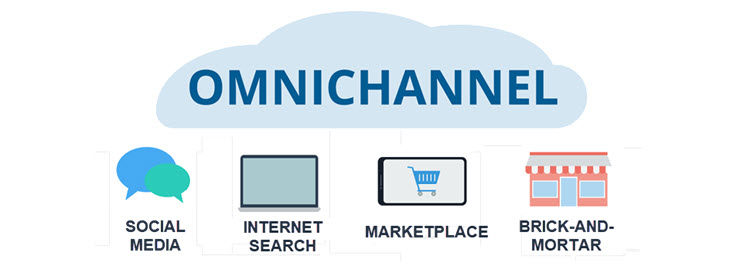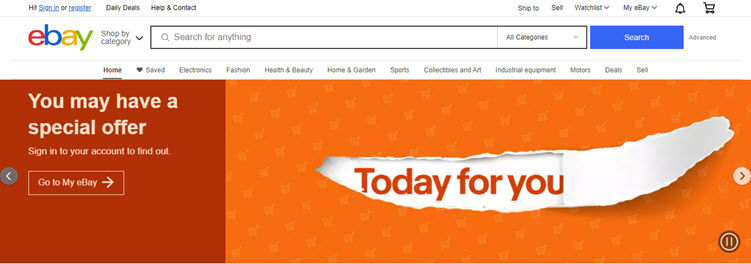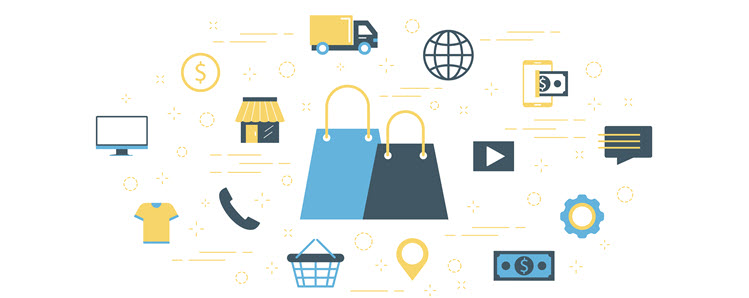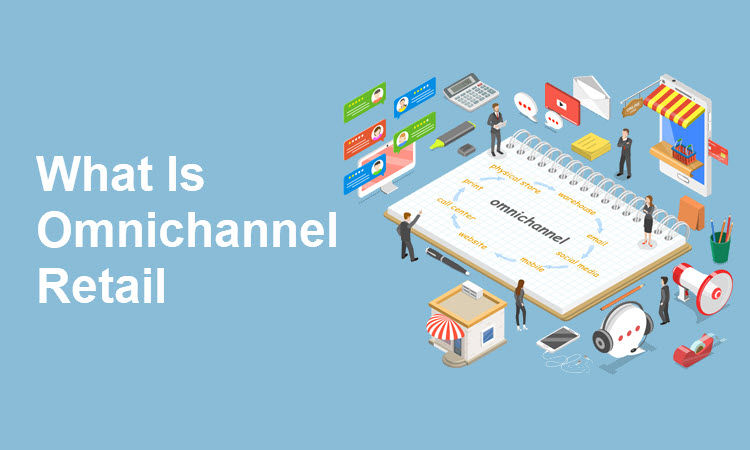Both brick-and-mortar retail and ecommerce have changed significantly over the last ten years.
The unparalleled development of mobiles and their use in ecommerce, the technological advancements behind ecommerce platforms, and the COVID-19 pandemic are the three most important factors affecting the ecommerce market.
All these changes have paved the way for omnichannel retail.
This article explains what omnichannel retail is, how it benefits merchants, and what it takes to introduce an omnichannel retail strategy.
Omnichannel Retailing Definition
Omnichannel retail offers customers a unified shopping experience through mutually connected marketing and sales channels.
It includes various touchpoints, from e-stores and mobile shopping apps, to traditional brick-and-mortar stores. In omnichannel retail, customers seamlessly switch from one touchpoint to another, gathering information about the product or service they’re interested in before making the purchase.
At the same time, merchants collect valuable data about their customers’ shopping habits from the channels they commonly use.
Single Channel Vs. Multichannel Vs. Omnichannel Retail

Omnichannel and multichannel are often used interchangeably. However, they are two different concepts. There is also the traditional single-channel approach to retail.
Here are the main differences between these models.
Single Channel
Single-channel retail targets customers via only one independent sales channel. That channel can be a brick-and-mortar store, an online store, an Instagram shop, or any other touchpoint. The distinguishing feature of this approach is that there is only one way for the buyer to access the brand and make a purchase.
Multichannel
Multichannel retail includes several separate channels that are not mutually connected or synced. Each of these channels aims to get the customer’s attention and make them buy a particular product.
In a multichannel approach to retail, the more mediums you can offer to customers, the better. For instance, a social media business page, an online store, and an ecommerce mobile app are three sales channels that work separately in a multichannel approach.
Note: Learn more about omnichannel and multichannel from our article Omnichannel Vs. Multichannel: What Are the Differences?
Omnichannel
Omnichannel retail is based on various mutually connected customer-centered channels. The customer and product data are synced throughout different touchpoints. No matter what medium or touchpoint the customer interacts with, everything is part of a single, continuous brand experience.
Here’s an example of an omnichannel experience: a customer finds a jacket they like in a brick-and-mortar store. They use a self-serve in-store tablet to find out more about the jacket and then they try it on in the changing room. Finally, they buy it either in the store or online.
Note: CCBill provides technical solutions for omnichannel merchants to accept payments online, on mobiles, in-store, or in-app.
Different Types of Channels in Omnichannel Retailing

Merchants can use various omnichannel retailing channels to generate leads, convert them into customers, and ensure recurring revenue.
These are the main types of channels in omnichannel retail:
Social Media
Social networks, like Facebook, Instagram, and TikTok, are valuable omnichannel retail channels.
As reported by Statista, Facebook and Instagram, now under the Meta brand, combined have more than 3.5 billion users. The Meta digital universe launched a new era of omnichannel retail. Even though shopping via Instagram and Facebook was possible before, these social media marketplaces now offer advanced options for businesses to interact with customers.
Internet Search
Ordinary Internet search still has a great potential for merchants to reach out to new customers.
A report shared by Smart Insights shows that in January 2022, around 24% of shoppers used an online price comparison tool before making a purchase. The same source reports that 58.4% of shoppers purchased a product or service online every week during that month.
Therefore, using Google My Business to get closer to customers and placing Google ads are still effective ways of winning over prospective buyers.
Marketplaces
Using traditional online marketplaces as part of an omnichannel retail strategy increases your exposure to potential buyers and reduces the possible background work. These organizations have established procedures and rules for business owners to sell their goods or services.
eBay
Selling via eBay means connecting with a company present in more than 190 countries and exposing your business to almost 170 million active users worldwide, who generate more than $83 billion of global market value.
There are no annual, monthly, or account setup fees on eBay. You only pay an insertion fee when placing a listing and a sale fee once you sell a product.

Walmart
One of the largest retailers in the US with a global presence, Walmart is an excellent marketplace for merchants setting up an omnichannel retail strategy. This marketplace ensures connectivity across numerous channels with more than 440 million active users and several affiliate websites. With social media presence, a shopping app, and numerous brick-and-mortar stores, Walmart offers a variety of options for implementing a successful omnichannel retail strategy.
However, bear in mind that you first need to fill out an application and wait for Walmart’s invitation. If they don’t need what you offer, you won’t get access to this marketplace.

Amazon
Amazon is still the most popular online marketplace in the world. Merchants offering products on Amazon make their brand visible to about 2.4 billion monthly visitors.
They might not be the most affordable marketplace, though, due to different fees, but it’s expedient, reliable, and experienced. Working with an experienced online retailer is important, especially for new merchants trying to succeed in omnichannel retail.
Also, Amazon Web Services (AWS) provide merchants with convenient and valuable tracking tools to enhance the customer experience on this marketplace.

Brick-and-Mortar Stores
Brick-and-mortar stores still play an essential role in commerce. After two years dominated by the pandemic, some customers now crave in-person shopping. What is more, some previously digital-only brands are opening brick-and-mortar stores.
If you have a physical store, install digital touchpoints, such as self-serve tablets or monitors, to help in-store buyers experience omnichannel retail on the spot.
Advantages and Disadvantages of Omnichannel in Retail
Using omnichannel in retail brings many advantages, and several disadvantages, as follows:
Advantages
The main advantages of omnichannel retail are:
- Increased customer expenditure. A study conducted by the Harvard Business Review has shown that omnichannel retail campaigns make customers spend more and increase the brand’s revenue.
- Higher engagement rate. The more connected channels a customer interacts with during a single shopping experience, the higher their overall engagement rate. Each channel triggers more customer activities, enhancing their connection with the brand and the customer lifetime value (CLV).
- Boosted acquisition and purchase rate. When implemented properly, omnichannel retail reaches more users than the single-channel or multichannel approach. It boosts the customer acquisition and purchase rate while reducing churn.
- Improved business efficiency. For merchants using omnichannel in retail, valuable customer data pours in from different, mutually connected sources. Thanks to this data, merchants can offer features suited to their customers’ purchasing preferences. This includes enabling automatic payments, which allows for recurring billing and other options that ensure secure and efficient payment processing.
- Stronger customer loyalty. When customers interact with a retail brand across various online and offline channels, they get more accustomed to the brand. Conversely, the more services a customer uses, the more data they leave to merchants. Hence, merchants obtain more valuable customer information to work with and turn occasional buyers into loyal recurring customers.
- Effective inventory tracking. With omnichannel tools by their side, merchants are able to gather relevant information on their inventory and predict potential shortages. In retail, such data helps merchants make future investments in supplies based on their customers’ shopping preferences.
- Smooth customer experience. Enabling a customer to check the same product on the merchant’s website, a mobile app, a social media channel, or in the store creates a smooth customer experience. The more comfortable a customer feels, the more likely they are to make a purchase, come back for more, and recommend the brand.
Disadvantages
The omnichannel approach to retail presents certain challenges:
- Demanding communication features. In omnichannel retail, communication between teams overlooking the channels needs to be as fast and smooth as possible. If only one channel doesn’t respond appropriately to customers’ requests, the entire omnichannel experience is affected.
- Complex technical requirements. Building back-end solutions to support omnichannel retail is not simple. The front end also needs to be user-friendly and attractive to ensure a comfortable customer experience. Not all merchants are ready for the substantial upfront investments required for this.
- High price. Even though omnichannel retail is the future of commerce, it is still costly. You need to work with experienced and knowledgeable software engineers to have everything running smoothly. However, new solutions will become more affordable in the time ahead.
Omnichannel Retail Trends

These are the crucial omnichannel retail trends that merchants need to consider in 2022 and beyond.
- Video content for higher sales. About 55% of buyers say they watch online videos during in-store purchases. Be it product characteristics, descriptions, or practical uses, video content is becoming essential for omnichannel retail.
- Contactless shopping. The COVID-19 pandemic has additionally segmented the already diverse ecommerce world. Many people have become used to contactless shopping and this trend is here to stay in 2022. Let your customers pay online and pick the goods up in the store or provide timely shipping when requested.
- Online shopping assistants. Customers who have embraced online shopping as the primary purchase method must not feel alone in their shopping experience. Providing online shopping assistants, such as chatbots or human chat agents, adds to a holistic omnichannel retail experience.
- Showrooming goes forth. For some people, the pandemic meant alienation and loneliness. These people want to get back to stores to touch, feel, or try on different products. As this is a valuable market segment for omnichannel retailers, open your stores for such customers. Let customers combine online shopping and in-person showrooming to take the best of both worlds.
- Multichannel analytics. Every omnichannel retail strategy is at the same time a multichannel strategy, but not vice versa. With that in mind, analyze each channel used in your omnichannel retail campaign to see whether they hit the right target and bring the desired results.
- Diverse omnichannel customer journey. Ensuring a frictionless omnichannel customer journey is vital in 2022. Customers want to freely roam from channel to channel to examine, compare, and purchase goods and services. The more options they have, the more likely they are to stay with the brand in question. For instance, when a customer buys a product from your store, consider letting them either pick it up in-store or have it shipped home.
- Digital brands going physical. While most brick-and-mortar stores are opening their online counterparts, some digital brands are going in the opposite direction by opening brick-and-mortar stores to engage locally.
- Stronger bonding with customers. Brands already using or getting ready to utilize omnichannel in retail should use it to bond more closely with their customers. For instance, using a customer’s online shopping data to send them a gift or a special discount via snail mail is an effective way to show you care.
Note: Refer to our article on omnichannel retail trends for a more in-depth look at the trends, stats and predictions.
Omnichannel Retail Strategy

Developing an omnichannel retail strategy is not easy, and it takes a lot of research and planning to implement.
These are the steps that will help you deploy your omnichannel retail strategy.
1. Research Your Customers’ Habits and Background
Analyze and categorize customers to figure out who they are, where they come from, and what they need. This information will help you create a buyer persona.
Pinpoint your buyer persona’s preferred channels and promote products via channels with the highest return on investment. For instance, if you discover that your buyer persona uses Instagram and Amazon more than Facebook and eBay, focus on their preferred online channels.
Analyze whether customers visit your omnichannel touchpoints via desktop computers or mobile devices. It will provide you with valuable data for preparing a comprehensive sales strategy that targets the right digital media.
Go through Google Analytics reports to identify what online places direct people to your website or e-store. Knowing how customers find your business is vital in turning them into repeat buyers.
2. Merge the Online and Offline
Today’s buyers use both online and offline channels for a single purchase. Some like to check the product online before they get to the brick-and-mortar store. Others order online but not before checking the product out in the store or may even decide to collect at the retailer’s physical location.
To help customers easily switch between these two channels, combine online and offline offerings. Moreover, regularly update the product catalog so that customers can buy the same products in the store and online. Install tablets and monitors in your stores to let customers know more about your products and services.
Successfully merging online and offline sales channels is at the core of a well-designed omnichannel strategy.
3. Provide Excellent Cross-Channel Support
Ensure cross-channel customer service to keep customers by your side as long as possible. Call and live chat agents, chatbots, email support, and in-house assistants are all equally necessary for omnichannel retail.
Map different routes for customers based on the issues they’re experiencing.
A customer might come across a product they’d like to buy on your Instagram page. They click on the product link which directs them to your business website, but there’s no product in question. This is the critical point for saving the potential buyer by offering adequate support in no time. A satisfying resolution of this situation would be having a chatbot ask the customer if they need help. As they say what went wrong, the chatbot directs the customer to the relevant support agent. All this needs to happen in a matter of seconds to keep the buyer’s attention.
4. Enable Purchasing in Every Channel
Sell the same products via every channel included in your omnichannel retail strategy. Your business website and mobile app, social media channels, the brick-and-mortar store, and any other channel you’re using needs to lead customers to a checkout where they can complete a purchase and successfully finish their omnichannel customer journey.
Since some customers want more time to think about their next purchase and analyze the options, you need to be ready when that moment comes.
For instance, they might be learning about a product for some time and find it on your website, read a relevant article on your blog, and see other buyers’ reviews. Then they go to Instagram and suddenly decide they’d like to buy it after all. In this case, a business that offers shopping via Instagram would make a sale. One that doesn’t do so would lose a potential buyer, most likely for good.
5. Use Channel Integration Solutions
Omnichannel retail, and ecommerce in general, require the application of appropriate technological solutions. Selling goods and services via different mutually related channels calls for an integrated approach to inventory. You need to track available and unavailable items in real-time to avoid shortages and misunderstandings with customers.
What you also need is a centralized source of product data to avoid entering this information separately for every sales channel.
Apply tech-based channel integration and data sync management solutions to follow all the digital traces a customer leaves when using different channels and collect invaluable information to create customized offers and spot upsell opportunities.
6. Rely on Automation for Higher Efficiency
Utilize automation whenever reasonable to reduce operational costs and ensure an enhanced customer experience, as follows:
- Define what tech integrations are critical for your omnichannel retail goals so that developers and other tech professionals know their priorities.
- Provide ecommerce chatbots as the front end for common customer questions and define in advance what types of issues are redirected to support agents.
- Consider using behavioral triggers to provide a customized shopping experience for every customer.
- Use card abandonment tracking tools to redirect buyers back to your website so they can finish the purchase.
- Set up automated follow-up messages to improve the post-purchase experience.
7. Test Everything
Test everything that can be tested, from your business website and e-store to the user experience in every channel included in your omnichannel retail strategy.
Make testing a two-way process. Test your software to see how the website and any other touchpoint respond to customers’ requests. Then put yourself in the customers’ shoes and test how user-friendly your omnichannel offerings are.
Try different formatting for different products and services and test them on various segments of buyers. The more elements contained in your omnichannel retail strategy you test, the more data you’ll have to work with.
Ideally, testing and automation are used together in omnichannel retail to inform merchants in real-time what aspects of their businesses are doing well and what sections need to be fixed.
Conclusion
We are witnessing the dawn of omnichannel retail. With technological progress, innovations help merchants gather data throughout different offline and online channels, helping them make sound business decisions.
It is important to start implementing omnichannel retail features on time and offer your customers a unified experience across different channels and platforms.
The guide above will help merchants understand omnichannel retail and use its features to prepare for an omnichannel business future.
